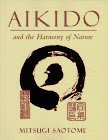One of the reasons one might start doing aikido is that you want to feel safer. I too wanted to gain some self-confidence and just generally, wanted to feel safer in the street at night (though the places I lived in before coming to London were not particularly unsafe).
Another aspect of safety in aikido appears when you are actually practicing. You obviously don't want to harm either yourself or your partner or anyone practicing within the dojo. For this reason, i.e. to avoid injuries, we should train carefully and should not do silly things to show how much you know ("let's throw the uke as far as we can...").
When practicing, it's always the tori who controls the technique, hence he is responsible for the safe execution of a technique. The tori can control where the uke is thrown as the uke sometimes can't see where's some space to be thrown (and the tori is supposed to lead the uke anyway).
There is one more way to prevent injuries, and this is clothing. If the sleeve of your gi bottoms are too long, you or others can step on it and, because you can't step properly, someone might get injured. Hakamas are even wider, looser-fitting and might also cause injuries when they are too long or the aikidoka is not prepared to wear them safely.
I think this is why many aikido dojos do not allow students to wear hakama until they acquire certain skills and experience (3rd, 2nd kyu, 1st dan). Two things I wouldn't like are wearing hakama from the first day or not wearing hakama at all. I think these are rather two extremes as a beginner doesn't even know how to walk (especially in shikko dachi) and I wouldn't like to take the nice look of a hakama away from advanced students. Saying that someone doesn't wear hakama at all is being overcautious but tell me if I'm wrong in this.
The other thing is the colour of the belts. I'm much more flexible in accepting coloured belts for safety reasons but I also think that as the Japanese could live without these colours for ages so should we. The purpose of aikido is also to work, practice together with anyone so if you don't know how advanced your partner is you can either ask or start the techniques slowly to find out where s/he is in his/her Way.
Safety is for not getting injured and concerns about it should not take anything away from people. I don't go into a dark alley during the night if I don't feel safe but I shouldn't feel unsafe during a walk at night anywhere (e.g., a well lit street). If someone really wants to hurt you they will, but such mean people are, I hope, very rare. Similarly, accidents can happen in aikido trainings but serious accidents are also very rare.
Articles, photos, videos and discussions about Aikido. From people who practice this martial art in Wimbledon, London, UK.
Latest posts from Connor & Zolley's Aikido Site
Blog Archive
Our own Aikido classes
Subscribe to...
Our organisation

Aikido Alapítvány (Aikido Foundation, Hungary):
- International technical advisor: FUJITA Masatake Shihan (8th Dan Aikikai)
- Technical director: ELSNER László (5th Dan Aikikai)
- Chair: VASS Zoltán (3rd Dan Aikikai)
Label Cloud
- addiction (2)
- aikido (37)
- aikido club (4)
- aikikai (4)
- announcement (1)
- applications (1)
- art (1)
- attack (1)
- awards (1)
- axe (1)
- beginners (3)
- beginners guide (5)
- belt (4)
- blog (3)
- bow (3)
- business (1)
- change (2)
- cherry (1)
- China (1)
- chopping wood (1)
- colour (3)
- competition (2)
- connect (1)
- criticism (1)
- culture (4)
- cut (1)
- dan (1)
- demonstration (2)
- dojos (1)
- doshu (2)
- Dragons' den (1)
- England (1)
- etiquette (1)
- exercise (1)
- experience (3)
- fabric (1)
- fire (1)
- first (5)
- fold (3)
- food (1)
- funny (4)
- gi (2)
- hakama (7)
- harmony (1)
- Heroes (1)
- Hungary (1)
- injury (1)
- instructions (1)
- itp (1)
- Japan (7)
- kanji (2)
- kata (1)
- katana (1)
- keikogi (2)
- ki (2)
- kids (2)
- kyu (1)
- language (1)
- learning (1)
- logo (1)
- london (5)
- martial arts (5)
- maturity (1)
- meditation (1)
- moriteru (1)
- O'Sensei (1)
- obi (2)
- Olympic Games (1)
- onlineaikido (3)
- organizations (1)
- patience (3)
- pictures (7)
- plum (1)
- Poirot (1)
- posture (2)
- put on (1)
- question (3)
- quote (2)
- relativity (1)
- respect (2)
- review (1)
- rolling (1)
- safety (1)
- Seven samurai (1)
- shomenuchi (1)
- shuhari (1)
- size (1)
- software (1)
- Southfields (1)
- speed (3)
- squirrels (1)
- Steven Seagal (1)
- stories (1)
- subscription (1)
- techniques (3)
- thinking (1)
- tie on (1)
- time (3)
- tips (2)
- tori (3)
- tradition (2)
- training (16)
- translation (2)
- trust (1)
- trying (1)
- TV (1)
- ueshiba (2)
- uke (3)
- video (2)
- water (1)
- wimbledon (5)
Latest comments
Our Authors
Links
Blogs
Search for books









No comments:
Post a Comment